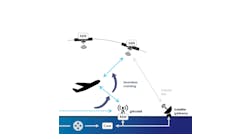Radio Altitude: The instrument of choice
Radio Altitude
The instrument of choice
By Jim Sparks
Altitude has always been a No. 1 concern of aviators. Even in the worst case, if an aircraft had enough altitude, a safe landing could be planned and carried out. Pressure-sensitive altimeters have always been the instrument of choice to provide flight crews with their critical data. Barometric altimeters per regulation have to be accurate within a range of 20 to 250 feet depending on surrounding pressure altitude. The fact that this device is sensitive to changes in pressure referenced to a sea level environment make it blind to the rise of mountain ranges or other obstacles to the flight path and with a 20-foot accuracy at sea level, would most likely make a precision landing with sole dependency on this device a bumpy situation. In fact changes in atmospheric pressure from one side of an airport to another can provide a noticeable altitude error.
History and benefits
Lloyd Espenschied first created the radio altimeter in 1924 but it took
14 years before Bell Labs was able to put the device in a form that was adaptable for aircraft use and utilized an FM frequency.
Although a valuable stand-alone information source, radio altitude can also be supplied to ground proximity warning systems (GPWS) or terrain awareness and warning systems (TAWS). In addition, information is often supplied to flight guidance systems to enhance flight deck visual queues used by the flight crew during takeoff, instrument landings, or go around conditions. In many cases radio altimeter systems will also provide information to alter gain authority in automatic flight controls plus it is a primary sensor in the control of auto landing systems. Radio altitude may even be used by airframe systems to trigger landing gear warnings or even control systems that have an altitude stipulation.
How it operates A receiver transmitter (RT) working in conjunction with separate transmit and receive antennas makes up the majority of the system hardware. Operation requires the RT unit to send a signal to the transmit antenna which is then directed to the ground. When the signal hits the ground it is reflected back up to the receive antenna. The RT then performs a time calculation to determine the distance, as the altitude of the aircraft is proportional to the time required for the transmitted signal to make the round trip.A test feature is included and will provide the flight crew with an indication regarding the operational status and in some cases the accuracy of the radio altimeter. This test will not check the operation of the two antennas or the condition of the transmission lines.
Flight deck displays of radio altitude are also varied. Some systems have a stand-alone instrument while in other cases height above ground level can be displayed on an attitude indicator or an electronic flight instrument.
GPWS and TAWS information
Radio altitude is not only an important flight deck stand alone, it is
also a primary source of information for ground proximity warning systems (GPWS) or terrain awareness warning systems (TAWS).
Class A TAWS is a sophisticated system, however the Class B version will be much simpler. It will not include a radio altimeter or an air data computer. Instead it will rely almost entirely on the external satellite navigation position. There is an acknowledged weakness in the Class B TAWS system and questions arise about its ability to provide adequate levels of protection. With a Class A system if an error occurs and the aircraft approaches terrain, the radio altimeter is still available to provide the system with the capability to advise the flight crew.
Instrument landings
Instrument landing systems (ILS) are another area where radio altitude can play an important role. Instrument landings are classified based on ceiling height and visibility with Category I (Cat. I) requiring a minimum distance of 200 feet from the ground to the break out point of the lowest cloud layer plus a visibility enabling the pilot to see almost one half of a mile. Category II (Cat. II) has a ceiling reduced to 100 feet and requires around one quarter mile visual range and while Cat. III will allow an aircraft to land with a zero foot ceiling there are several different stipulations on visibility based on the type Cat. III landing performed. Radio altitude can play an important role in all of these conditions.
Another feature of radio altitude is the control of the rising runway that appears in conjunction with the ILS displays on many attitude indicators. In aircraft so equipped, whenever a navigation radio frequency falls into odd channels between 108 and 111.95 MHz, it will cause runway symbols to appear. This includes a vertical Glide slope pointer and a lateral moving runway symbol. The left and right movement of the runway is controlled by the localizer function of the ILS. This gives the pilot a reference as to aircraft position relative to runway centerline. Once the aircraft gets within 100 feet above the ground, the runway symbol will begin to rise. At the point where the aircraft main wheels just touch the ground the rising runway symbol will just contact the aircraft icon.
Automatic flight control systems may also take advantage of information provided by radio altitude. The gain or sensitivity of the auto pilot is often compensated as a result of the aircraft descending to lower altitudes and during approach to landing. With landings requiring slow flight conditions flight controls often require an increased deflection as well as responsiveness. In many installations the radio altimeter RT unit has discrete altitude presets. This data can be supplied to the auto flight computer to accomplish the flight control biasing. Should this bias not occur the result may be the auto pilot's inability to steer an accurate approach to the runway but all other auto flight functions work as they should.
Testing and operation
Avionics should be tested, ideally, as close to a flying or operational
configuration as possible. This means the aircraft is on the ground, with engines and all systems operating. It is not unusual for systems to interfere with each other. Radio transmitters, for example, are a common source of interference, as are electric motors, ignition, and poor electrical grounds. Transmitter radiation is often so great that it is difficult to eliminate.
In the case of operating engines, which supply electrical power buses, there is an engine-driven generator or alternator. Output can vary significantly with engine rpm. A ground power supply, on the other hand, provides a steady, clean power and may not expose problems. An area of significant difference is the radio signal environment. Aircraft in flight are bombarded with radio signals that can cause problems. An aircraft on the ground, however, is out of range of most signals and a ramp test may not exhibit the problem.
Major items that cause problems are the interconnecting wiring, connectors, and LRU trays or mounts. Antennas and coax cables are also candidates for a ramp test. It is important to evaluate these items because antennas mounted on the outside of aircraft are subject to environmental damage. Because of problems with interconnecting wiring and antennas, it is imperative that a ramp check be performed on newly installed systems. Thorough ramp tests reduce the need for flight tests, which are expensive.
Most testers for radio altimeters plug into the RT unit and will provide various altitude simulations. This will allow most of the flight deck displays to be verified plus various interfaced systems such as auto flight can be checked. This type of test does not check the integrity of the antennas or the coax transmission lines. Unfortunately these are the areas where problems often arise. Bonding issues on either the transmit or receive antenna can result in deterioration of the system. In fact paint applied to the antenna surface will often block the transmitted electrical energy as well as cause degraded reception. In some systems the transmit and receive antennas have to be positioned in a specific situation relative to one another in the aircraft. System manufacturer installation instructions should always be checked to verify proper position. Degradation of the coax cables can result in similar conditions. A frequent occurrence with coax cables is overtightening of cable clamps. This causes a change in the di-electric properties and will result in signal loss.
Troubleshooting the radio altitude system as with many avionics systems begins in the flight deck. Verifying proper operation of all, some, or none of the systems affected by radio altitude including visual flight queues such as EGPWS, digital altitude readout below 2,500 feet, decision height, and the rising runway not to mention auto flight interface will provide the line technician with significant information in solving problems regarding system operation.
New regulations that make EGPWS a requirement in certain types of aircraft will elevate radio altitude systems to a new position of prominence. With interfacing of radio altitude with airframe systems, the fun associated with troubleshooting these devices may soon be removed from the avionics technician and placed on the shoulders of the A&P.







